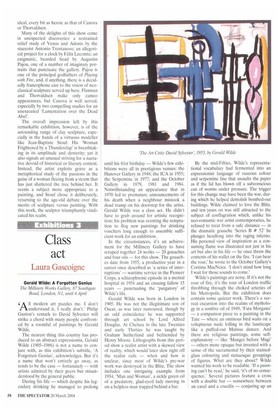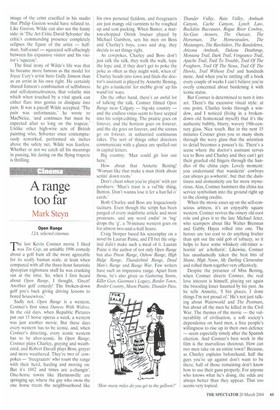Class act
Laura Gascoigrie
Gerald Wilde: A Forgotten Genius The Millinery Works Gallery, 87 Southgate Road, London, Ni, until 4 April
4 A 11 modern art puzzles me. I don't t-lunderstand it, I really don't.' Philip Guston's remark to David Sylvester will strike a chord with many people confronted by a roomful of paintings by Gerald Wilde.
The nearest thing this country has produced to an abstract expressionist, Gerald Wilde (1905-1986) is not a name to conjure with, as this exhibition's subtitle, 'A Forgotten Genius', acknowledges. But it's a name that won't entirely go away, as tends to be the case — fortunately — with artists admired by their peers but misunderstood by the general public.
During his life — which despite his legendary drinking he managed to prolong until his 81st birthday — Wilde's few exhibitions were all in prestigious venues: the Hanover Gallery in 1948; the ICA in 1955; the Serpentine in 1977; and the October Gallery in 1979, 1981 and 1984. Notwithstanding an appearance that in 1970 led to premature announcements of his death when a neighbour mistook a dead tramp on his doorstep for the artist, Gerald Wilde was a class act. He didn't have to grub around for artistic recognition; his problem was resisting the temptation to flog new paintings for drinking vouchers long enough to assemble sufficient work for an exhibition.
In the circumstances, it's an achievement for the Millinery Gallery to have scraped together 24 works — 20 gouaches and four oils — for this show. The gouaches date from 1955, a productive year in a career once described as 'a series of interruptions' — wartime service in the Pioneer Corps, a schizophrenic episode in a mental hospital in 1954 and an ensuing fallow 15 years — punctuating the 'purgatory' of Wilde's life.
Gerald Wilde was born in London in 1905. He was not the illegitimate son of Oscar, as was later rumoured, though by an odd coincidence he was supported through art school by Lord Alfred Douglas. At Chelsea in the late Twenties and early Thirties he was taught by Graham Sutherland and befriended by Henry Moore. Lithographs from this period show a realist artist with a skewed view of reality, which would later slew right off the realist rails — when and how is unclear, since most of Wilde's pre-war work was destroyed in the Blitz. The show includes one intriguing example from 1934, 'Man and Woman', a sickly green oil of a predatory, glad-eyed lady moving in on a helpless man trapped behind a bar. By the mid-Fifties, Wilde's representational vocabulary had fermented into an expressionist language of raucous colour and serpentine line that assaults the paper as if the lid has blown off a subconscious can of worms under pressure. The trigger for this change may have been the war, during which he helped demolish bombed-out buildings. Wilde claimed to love the Blitz, and ten years on was still attracted to the subject of conflagration which, unlike his neo-romantic war artist contemporaries, he refused to treat from a safe distance — in the dramatic gouache 'Series B # 52' he plunges headlong into the raging inferno. His personal view of inspiration as a consuming flame was illustrated not just in his art but also in his life — he once threw the contents of his wallet on the fire. 'I can hear the roar,' he wrote to the October Gallery's Corinna MacNeice. 'I don't mind how long I wait for those sounds to come.'
Wilde's paintings are noisy. If it's not the roar of fire, it's the roar of London traffic throbbing through the choked arteries of his Metropolis. But the exhibition does contain some quieter work. There's a surreal excursion into the realms of mythology in a sombre oil of 1949, Tata Morgana' — a companion piece to a painting in the Tate — where an ominous bird waits on a voluptuous nude lolling in the landscape like a puffed-out Matisse dancer. And there are religious paintings, some selfexplanatory — like 'Manger before Magi' — others more opaque but invested with a sense of the sacramental by their stainedglass colouring and statuesque groupings of figures. What are they about? Wilde wanted his work to be readable. 'If a painting can't be read,' he said, 'it's of no consequence.' Several pictures feature a cross with a double bar — somewhere between an easel and a crucifix — conjuring up an image of the artist crucified in his studio that Philip Guston would have related to. Like Guston, Wilde can also see the funny side: in The Art Critic David Sylvester' the critic's commanding presence completely eclipses the figure of the artist — halfman, half-easel — squeezed self-effacingly between his expansive visitor and his visitor's 'squeeze'.
The final irony of Wilde's life was that he became more famous as the model for Joyce Cary's artist hero Gully Jimson than as an artist in his own right. He certainly shared Jimson's combination of selfishness and self-destructiveness, that volatile mix which when touched by a vital spark can either flare into genius or dissipate into pain. It was a payoff Wilde accepted. 'The pain was unfortunate,' he wrote to MacNeice, 'and continues but must be expected after so long on the trapeze.' Unlike other high-wire acts of British painting who, Sylvester once contemptuously remarked, performed six inches above the safety net, Wilde was fearless. Whether or not we catch all his meanings in passing, his daring on the flying trapeze is thrilling.



















































































 Previous page
Previous page